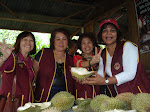The Batik art designs have found their way into the lives of many. Read on to know more about this extremely popular form of art.
Instant Tie and Paint Process:
The word batik (pronounced Bateek) means "wax written" and this is basically what batik is. It is a way of decorating cloth by covering part of it with a coat of wax and then dyeing the cloth. The waxed area keeps its original color and when the wax is removed the contrast between the dyed and un-dyed areas makes the pattern. A technique of hand-dyeing fabrics by using wax as a dye repellent to cover parts of a design, dyeing the uncovered fabric with a color or colors, and dissolving the wax in boiling water.
Initially Batik Tie & Dye was popular only as a hobby but gained impetus only in recent years, It has achieved a status as an independent profession. A lot of people have turned it into a lucrative business. A number of colleges and educational institutes are also offering courses on this.
Artists are using these techniques to translate their own ideas not only into patterns and designs for useful materials, but also as an art form to produce two-dimensional decorative for walls and paintings. It is also a craft that is well within the capabilities of the non-specialist.
Batik is a fascinating craft , though people may hesitate to try because of the tedious and time consuming process involved. Big, bold designs in bright colors are most striking.
Bold and loud colors are known to be used for Batik Tie & Dye processes. The age-old form of Tie and Dye does not allow the application of many colors at a stretch. Fabric needs to be tied and colored, washed, untied and dipped in color again for more than two colors. The Instant Tie and Paint process gives you the freedom to tie the fabric, pick up the brush and paint the various sections as per your desire. Once the fixer is applied, it needs to be left overnight and washed the next day. Untie the fabric to see the magic unfold!
